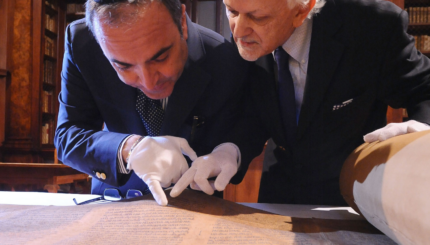Midrash negotiates the two forces whose encounter generates the creative tension of rabbinic culture as a whole–change and tradition. Broadly speaking, midrash attempts to secure the Torah’s centrality amidst shifting social and intellectual circumstances and views.
While midrashic texts and statements can appear illogical and random when taken out of context, they are in fact the products of a holistic system guided primarily by middot (rules of exegesis) within a range of favored genres. The middot, several midrashic genres, and the general tendencies and principles of midrash will be discussed below.
The Role of Torah: Two Views
There are two primary, and at times competing, assumptions about Torah that are at the core of the midrashic enterprise. While scholars tend to doubt the historicity of these schools of thought, tradition holds that second-century figures Rabbi Ishmael and Rabbi Akiba and their respective followers disagree concerning the very nature of Torah.
Rabbi Ishmael and his school hold that Torah “speaks in the language of people”–that is, the way that people normally speak–and consequently its interpreters should not make too much of every textual quirk or inconsistency. The Akiban view maintains that the Torah is a perfect composition down to every “jot and tittle”–every tiny letter such as the yod, and every calligraphic flourish, such as the tiny “crowns” that appear on the tops of some letters in a Torah scroll–and that only an improperly trained exegete would mistakenly deem even a letter of Torah, let alone a syntactic or grammatical anomaly, superfluous.
With your help, My Jewish Learning can provide endless opportunities for learning, connection and discovery.
The viewpoints of both Akiba and Ishmael repeat throughout the midrashic canon. Despite the debate over “human” versus “divine” Torah language, Akiba and Ishmael share the vital principle that Torah is the only textual source appropriate for the continuing work of revelation. Even as it reworks, reorganizes, and reconceives Torah in radical ways, midrash grants Torah ultimate authority and endless attention.
The Middot
 Rabbinic tradition holds that the middot—collectively functioning as the exegetical rulebook of midrash–coalesce in three stages over three generations: the Seven Rules of Hillel, the Thirteen Middot of Ishmael, and the Thirty-Two Middot of Eliezer ben Yose ha-Gelili. While each middah (in the singular) ostensibly serves a unique role, in the interest of space only three middot will be explicated here. (The majority of the other middot bear at least some substantial relationship to these three.)
Rabbinic tradition holds that the middot—collectively functioning as the exegetical rulebook of midrash–coalesce in three stages over three generations: the Seven Rules of Hillel, the Thirteen Middot of Ishmael, and the Thirty-Two Middot of Eliezer ben Yose ha-Gelili. While each middah (in the singular) ostensibly serves a unique role, in the interest of space only three middot will be explicated here. (The majority of the other middot bear at least some substantial relationship to these three.)
The phrase kal v’homer is often translated as an a fortiori argument, whereby a less significant statement leads to a more serious example or vice versa. A practical paraphrasing of kal v’homer reads, “if case ‘X’ is true, then all the more so must case ‘Y’ be true.”
In Sifre Devarim 31 (a midrashic collection on the book of Deuteronomy), Ishmael and his descendants are portrayed using a series of kal v’homer statements to try to assert their ascendancy over Isaac and his children. “[If] Abraham was just one man and he inherited the Land and we are many men, so the Land should be given to us as an inheritance…Just as Abraham worshipped only one God and inherited the Land, isn’t it logical that we who worship many gods will inherit the land?” Rabbinic terminology is so pervasive, it would seem, that even characters within rabbinic texts use it—even if their logic is faulty.
Gezerah shavah, defined as “verbal analogy,” allows a midrash to infer the meaning of a word or root in Scripture based on the meaning of the same word or root in another place in the biblical text. In Tosefta Sotah 6:6 (as well as in similar versions in both Sifre Devarim and Genesis Rabbah), the ambiguous use of the verb m’tzahek expands the negative image of Ishmael, who is said to be m’tzahek with Isaac, based on varied connotations of the same verb in other biblical verses.
He is linked to idol worship as implied by parallels with Exodus 32:6, sexual impropriety following Genesis 39:17, making war as in Samuel II 2:14-16, and cunning as suggested by Proverbs 26:18-19. Like many biblical characters representing challengers to mythic Israel while sharing a common heritage, the figure of Ishmael inspires both polemic and respect.
Binyan av allows set categories of interpretation based on a shared word or phrase amongst a “family” of verses. For example, according to Rabbi Eleazar ben Pedat in the Jerusalem Talmud Sanhedrin 1:1, 18a, all phrases that begin “And God” refer to both God and God’s royal court, while statements that begin with “And He [God] said” share a common theme of pending disaster.
Midrash as a whole is highly verse-centric, preferring to atomize the meaning of words, letters and phrases, than to pursue textual cohesion across narratives, chapters, and books. The system of middot is the primary vehicle for this micro-reading and organization of Torah. Their use creates rich layers of character and subtext, connecting component parts of the biblical text in unexpected ways—and providing a certain sense of continuity, if not consistency.
It is worth noting that halakhic (legal) and aggadic (non-legal) midrash share the same traditional structures and interpretive rules, but because it is focused primarily on narrative and not law, aggadah generally has more freedom to take imaginative liberties with the biblical text.
Examples of Midrashic Modes
Several genres occur repeatedly in midrash, serving as formulaic bases for the interpretative imagination. The “proem”–known in Hebrew as petihah and in Aramaic as petihta—begins with a “far” verse (that is, one seemingly unrelated to the verse which the exegete seeks to interpret), generally from Ketuvim (Writings, the third of three major sections of the Hebrew Bible). This move initiates an exegetical romp that eventually leads to explication of a “near” verse from the Torah. The proem may have social-historical roots in sermons allowing teachers to display their knowledge and rhetorical skill as a supplement to public Torah reading.
The mashal (parable) has been described by scholar David Stern as the intersection of exegesis and narrative, whereby midrash both interprets a verse and presents a concise moral tale within one construct. A mashal from Lamentations Rabbah states, “And He has kindled a fire in Zion, which has devoured the foundations thereof” (Lamentations 4:11). It is written: ‘A song of Asaph. O God, heathens have entered Your domain’ (Psalms 79:1). A song! It should have said ‘A weeping!’ Rabbi Eleazar said: It is like (mashal le) a king who made a bridal chamber…”
The mashal, using the figure of the king common in this form, goes on to explain that just as an enraged father destroys his son’s bridal chamber rather than the son himself, allowing the boy’s pedagogue to sing in gratitude that the boy survives, so too does God destroy the Temple–Israel’s bridal chamber–rather than pouring out God’s wrath on the people themselves. Meanwhile, Asaph still sings, thanking God for Israel’s survival. Hence, “And He has kindled a fire in Zion, which has devoured the foundations thereof.”
Additional forms of midrashic genres abound. Midrashic texts overflow with puns, wordplay, and reversal of letters, alliteration, and allegory. Letters of key words shift, taking on related forms with different meanings. The Hebrew letters in a word are assigned their corresponding number value (gematria), revealing a hidden concept or message. For the midrashist, the apparent simple meaning or appearance of a word or phrase is often only the starting point for discussing an idea far beyond it.
Midrash as an Agent of Both Tradition and Change
With its multiple generations of authors, transmitters, and scribes, even redacted collections of midrash tolerate a great deal of narrative contradiction. Disagreement over the correct reading of a verse, or at very least multiple interpretations, is the rule rather than an exception.
Midrash does not, however, have much tolerance at all for abstractions or ambiguities in the biblical text. Despite Rabbi Ishmael’s caution to leave an “imperfect” text alone rather than risk absurdity, at times outrageous midrashim are connected with even the most mundane biblical verses or passages.
Isaak Heinemann, one of the pioneering scholars of midrash over the past century, notes that midrash can be categorized in two modes: creative historiography and creative philology. The former refers primarily to the filling of gaps in narratives and answering questions of the meaning of particular episodes or characters. The latter describes the playful and intricate close reading of words, letters, and calligraphic flourishes–whereby every possibly unit of information is ripe for interpretation.
Midrash provided the ancient rabbis with more than a system of deep analysis and discussion of Torah. It was also the classic rabbinic mode for exploring new and challenging ideas, stories and visions–within the familiar language and narrative of Torah.
Torah
Pronunced: TORE-uh, Origin: Hebrew, the Five Books of Moses.



